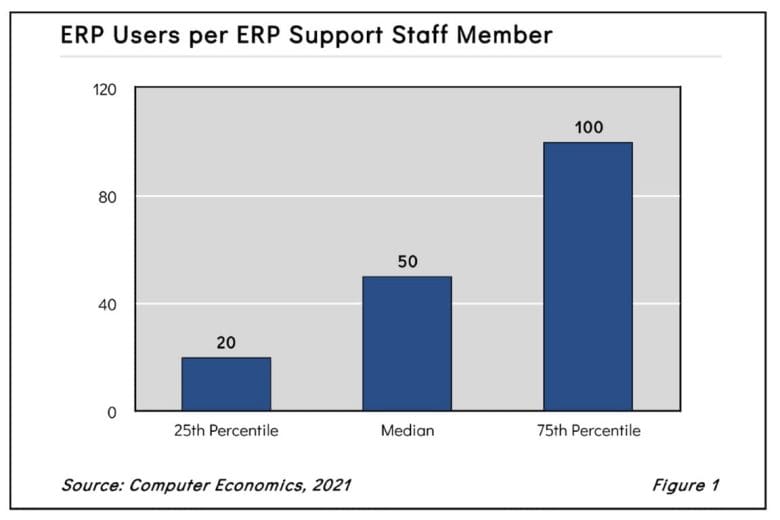For many IT organizations, enterprise resource planning (ERP) systems are at the center of the application portfolio, and understanding the support requirements of these systems is critical. The age of the system, type of deployment, and changes to business logic can drastically change support needs. Getting the support staffing wrong for your ERP system can be expensive, not just in support costs but in unmet business needs.
ERP systems can be major investments requiring substantial effort for implementation. Yet many organizations do not realize that over the life of an ERP system, the total cost of ownership is composed largely of ongoing support. To better understand the true support requirements for ERP systems, we devised a simple ratio: the number of ERP users divided by the number of IT personnel providing ERP support. We call this the ERP support staffing ratio.
Figure 1 from our full report, ERP Support Staffing Ratios, shows the typical range of ERP support staffing ratios for installations of all sizes and types. At the median, there are 50 users per ERP support specialist, rising to 100 users per ERP specialist at the 75th percentile and falling to 20 users at the 25th percentile.

These statistics show that there is a wide range of values for the ERP support staffing ratio. At the 75th percentile, there are five times as many users supported by each ERP support staff member than at the 25th percentile. Given this data, it is evident that in addition to the number of users, other factors influence the level of ERP support staffing. These include the size of installation, sector, maturity of installation, and upgrade frequency.
“ERP staffing is one of the hardest staffing decisions an IT leader can make,” said Tom Dunlap, director of research for Computer Economics, a service of Avasant Research, based in Los Angeles. “You can make mistakes both directions. You can easily spend too much. But if you don’t spend enough, your ERP system will not serve the business.”
The full report reveals other interesting nuggets. Newer cloud ERP systems are making gains, picking up market share from older systems, but the move to the cloud is not as fast as the hype would suggest. This is because ERP has been something of a last stand for on-premises systems. ERP is typically the most difficult business system to upgrade, as it touches so many areas of the organization. However, established ERP vendors now try to get nearly all new customers to deploy their cloud ERP systems. The vendors also are trying to get more of their legacy on-premises ERP customers to “lift and shift” to their cloud versions. This has implications in terms of the number and type of support personnel required.
Our definition of ERP support personnel includes programmers, business analysts, project managers, database administrators, help desk personnel, systems programmers, ERP end-user reporting specialists, and training and documentation personnel—all of whom support ERP systems.
In the full report, we analyze ERP support requirements in several ways. First, we look at the ERP support staffing ratio, which is the number of users of the ERP system divided by the number of ERP support personnel. We then assess this ratio by the size of the ERP installation. We also examine the data to determine the ratios by vendors/systems where we have the largest number of respondents. We examine the ratio by sector, age of installation, years since last upgrade, extent of modification, and type of deployment (on-premises, cloud, or hosted) as well. Finally, we provide recommendations on optimizing ERP staffing levels.
This Research Byte is a brief overview of our management advisory on this subject, ERP Support Staffing Ratios. The full report is available at no charge for Avasant Research subscribers, or it may be purchased by non-subscribers directly from our website (click for pricing).

